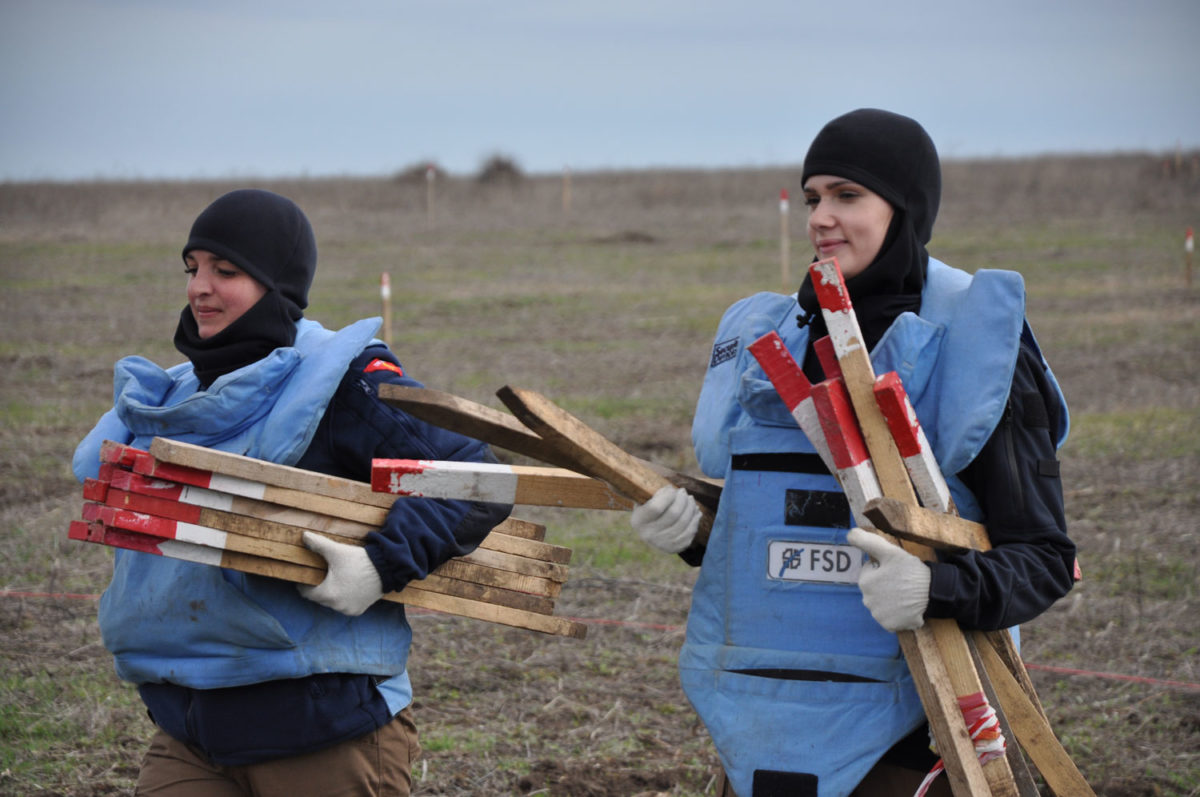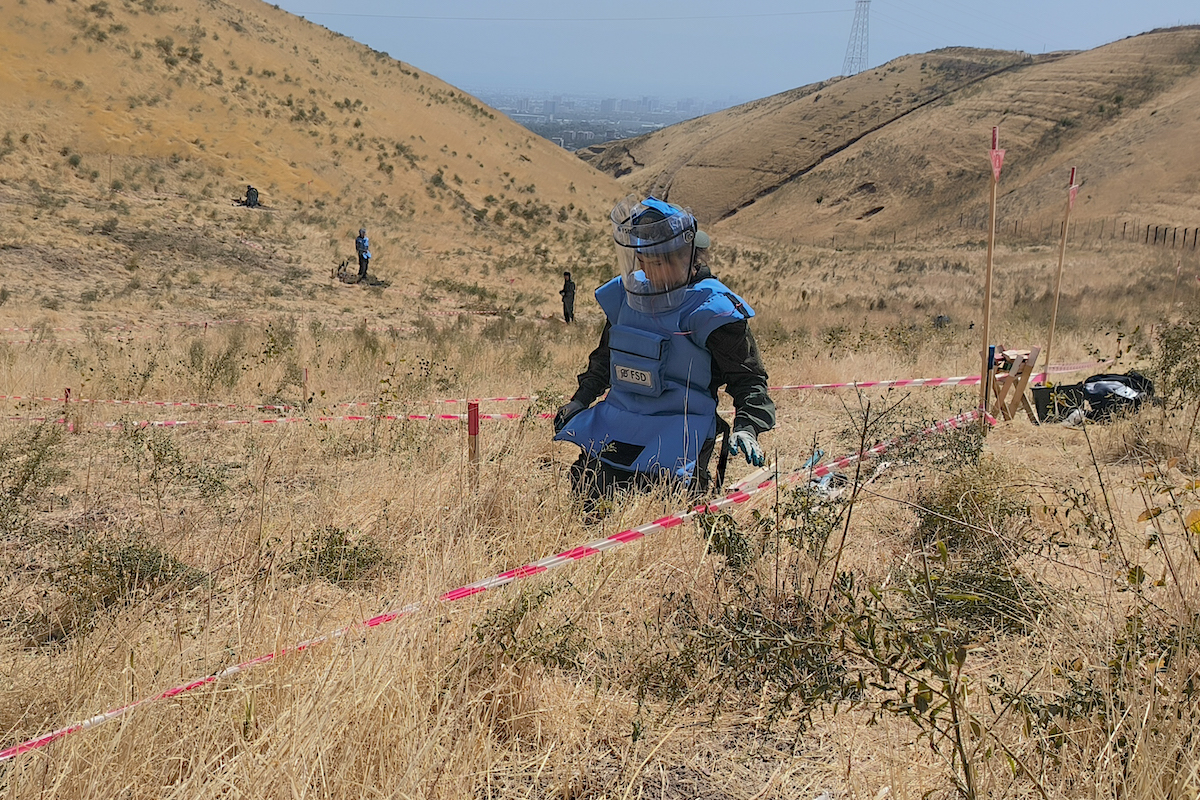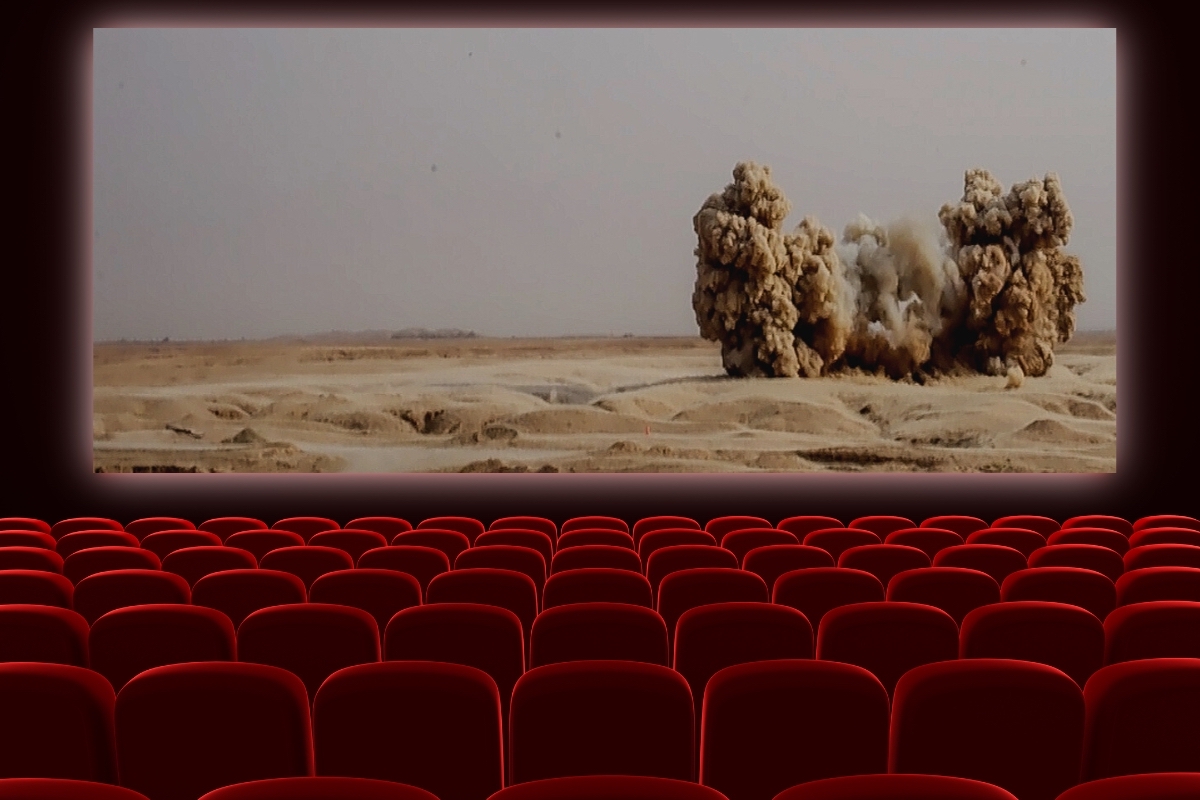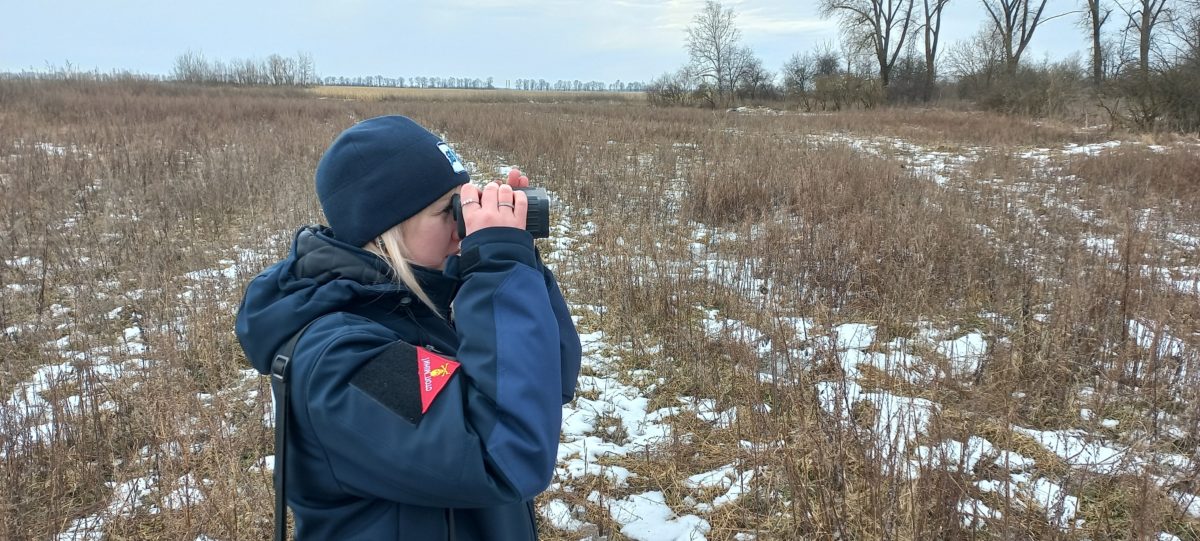Mine clearance is certainly not a trivial business. But that doesn’t mean it is a daredevil job. Each step of the work is carefully planned, carried out and recorded using tried and tested routines.
As a zero risk environment does not exist, risk must be minimized, both for the beneficiaries, who are promised secure land, and for the deminers’ safety. It is also crucial to optimize the resources available, as demining is an extremely expensive activity, sources of funding are limited and donor funds must be spend efficiently to ensure best practice and value for money. Demonstration in video :
A deminer never works alone. In Iraq, a clearance team consists of a team leader, five deminers and a medic. Two vehicles are used: a car to transport the deminers and the equipment and an ambulance for medical support and evacuation. Each demining team is allocated a “task”, which is a zone that the Iraqi Directorate of Mine Action has determined needs clearance. The team leader updates essential information about the task in question on a briefing board set up in the “control point”, the place where the ambulance and the medic are also stationed, near the zone to be treated.
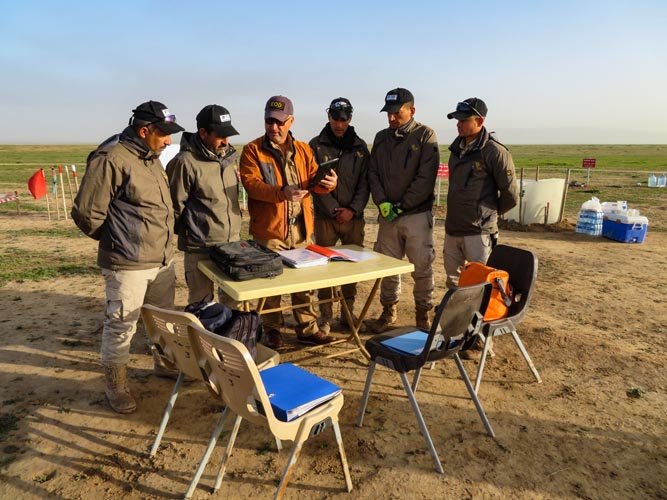
The picture below shows the briefing board of the task underway at Mahana village. Reading from the top, it indicates which FSD team in charge of the task (Team 7), the identification number of the task (036), the date the demining started (29th November 2018), the area that has been decontaminated so far in square metres (306,000m2) and the number and type of improvised explosive devices (IEDs) that have been cleared to date. “Pot” refers to IEDs in which the explosive charge is contained in a section of a steel oil pipe (59 units), “plastic pot” to those in which the explosive charge is in a plastic container (25 units) and “drum” when a jerrycan has been used (76 units).
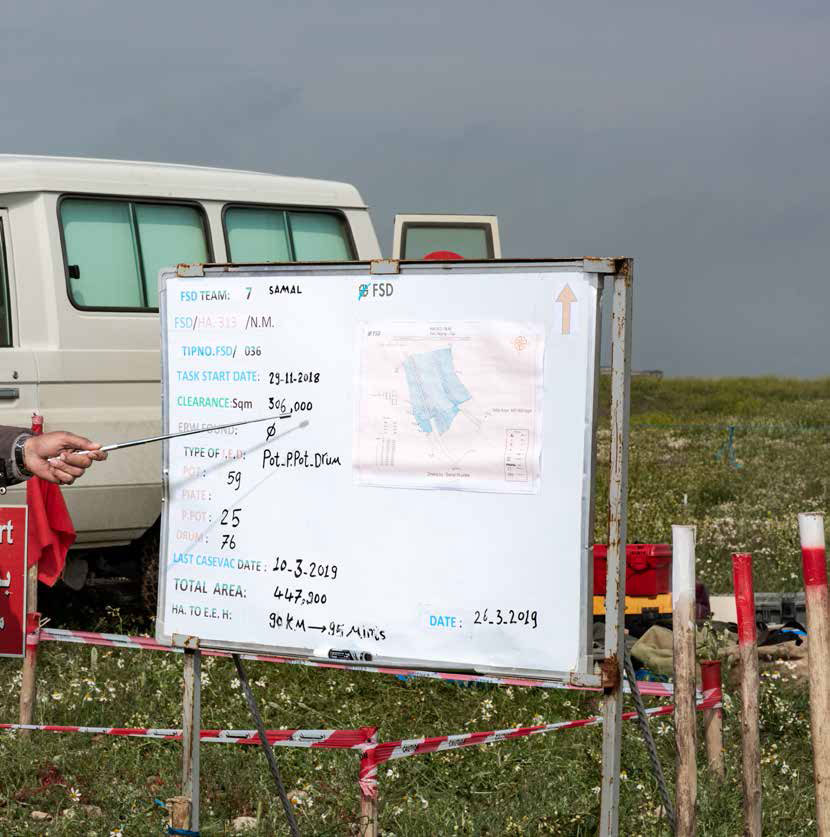
These are not small devices. Each contains between five and 20 kilos of explosives, which is enough to kill a person or even destroy a vehicle. Most IEDs were made in Mosul. Some were manufactured in a plastics factory that previously made items for domestic use and was converted to produce these improvised devices by ISIS.

Under the count of neutralized IEDs the date at which the last exercise in evacuating injured persons took place is shown (10th March 2019). This type of simulation needs to be carried out at least once a month to guarantee that teams are always ready to intervene in an efficient and satisfactory manner if an accident should happen. Under the figure giving the total area of the worksite (447,900 m2), the team leader has jotted down the distance, 90km, and the driving time, 95 minutes, to the nearest medical centre. The scale of the task is shown as a polygon on the sketch map. The dots are the IEDs and the blue zone is the area that has been cleared.
In any given village, the clearance team starts by clearing the area where their work will have the greatest impact on the local population, which is not necessarily the most contaminated area. It could be around a school, in a field, along the main track to the village and so on.
Most members of the team are responsible for looking for explosive devices. When their detector finds metal, it makes a warning sound. The deminer will then attempt to determine exactly where the metal object is located and will call the team leader. The team leader will locate the object more precisely and if possible identify the different elements of the IED before marking the position of the device with red paint. The deminer then marks out a zone around the IED using wooden sticks and marking tape.

After marking the location, a highly qualified clearance expert – local or international – will come to excavate the IED and examine it more carefully. If it is possible, the IED is deactivated, then a hook and a rope is attached to the device to move it remotely from a safe distance of 100 metres away in case the device contains a second,
hidden switch. The explosive charge and the detonator are finally transported to a secure place where they will be retrieved by Iraqi security forces for destruction at a later date. Large quantities of IEDs are regularly collected in a suitable place and then destroyed using a controlled explosion.
In the event that the IED cannot be moved safely, it is destroyed in situ.
Disposing of IEDs in buildings is another matter altogether. In this situation, it is very difficult to use metal detectors. Everyday objects and, sometimes, the infrastructure of buildings themselves are full of pieces of metal so a metal detector would go off constantly. In general, disposal teams work visually. They look through windows to make sure no explosives are hidden behind the door so they can enter safely. If there is any doubt, it is sometimes better to go through the window. Rooms are then systematically examined to find signs of potential explosive traps. In some instances, disposal teams use their ‘hook and line kit’: they attach the hooks to doors, drawers or other suspect objects, then leave the house, stop at a suitably safe distance, then pull on the cables to move the object.
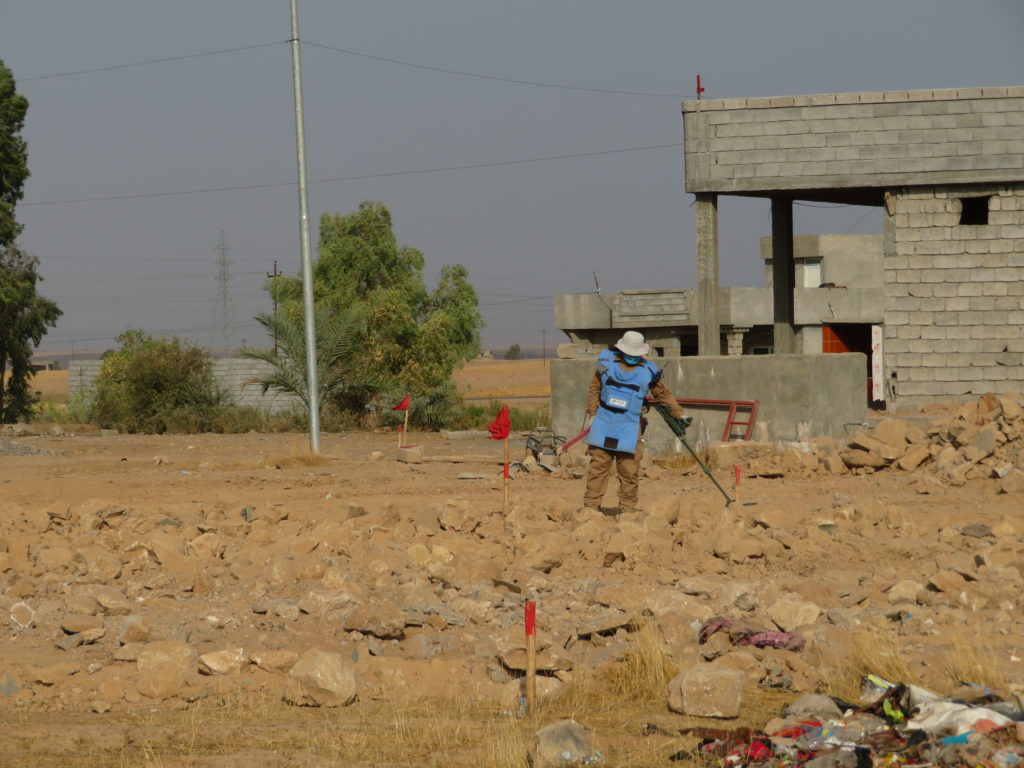
If a building has been partially or totally demolished, it is difficult to search for explosive ordnance in the ruins. Therefore, at the end of 2018, FSD acquired two earth moving and construction machines to use to remove rubble. These machines had to be modified so they could be used in mined areas; the cabins have been reinforced to guarantee the safety of the drivers. These machines can also help deminers excavate IEDs from fields, for instance in summer when the ground is extremely hard and difficult to dig.
A medic is constantly close at hand during demining operations. He or she is recruited from the health sector and then specifically
trained to work in a demining context, learning how to react in the event of an accidental explosion. Happily, there are very few accidents and the carers spend most of their time nursing small wounds and in preventative actions. They engage with the deminers to make sure they feel well, checking, for example, that they are properly hydrated during very hot weather. During the week, the deminers sleep in a rented house close to their mission. At the weekend they generally return home.


